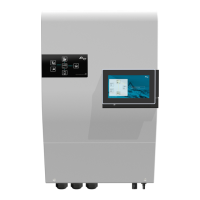Studer Innotec SA
next3
28 V 1.3 © Studer-Innotec SA next3 Tech manual
5.2.1
Dimensioning the battery
The battery bank is dimensioned depending on the user's daily energy consumption and the number
of days of autonomy required. It is sized also in function of the wanted daily Depth Of Discharge
(DOD).
The dimensioning of the battery must also consider the power and the type of loads that are
connected to the inverter. As rule of thumb, the maximum power of a lead acid battery is given with
the capacity divided by five (C/5), in that case if all the power of the next3 is wanted (16kW), the
capacity of the battery should be at least16000*5/48=1666 Ah.
For lithium, see the maximum power defined by the manufacturer as lithium batteries are generally
rated with a much higher current (C/3 or even 1C).
Take into account the surge power of loads, for example for motor starting and the overload
capacity of the inverter to dimension your battery system.
5.2.1.1 Battery bank design
Lead batteries are usually available in 2Vdc, 6Vdc or 12Vdc blocks. To get the correct operating
voltage for the next3 (exclusively 48Vdc), several batteries must be connected in series. The capacity
of the batteries can be increased using a parallel connection of several battery strings.
The various cabling options for the battery are presented in figures below:

